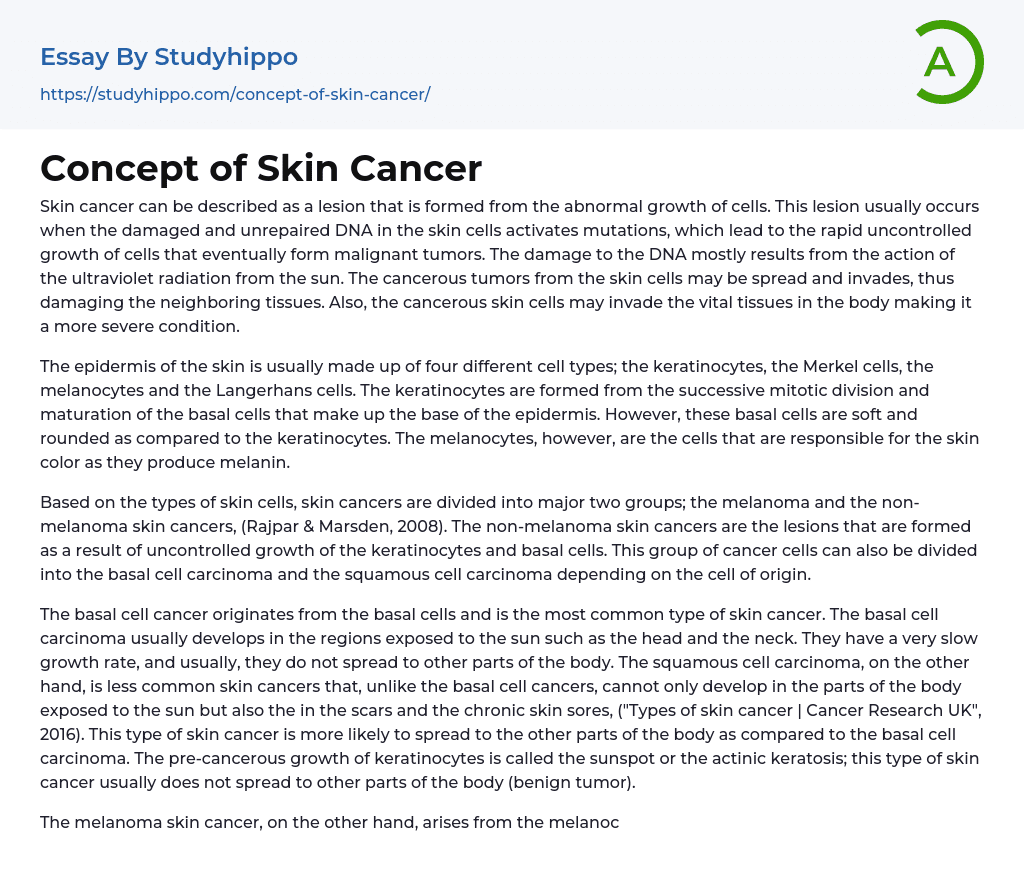Abnormal cell growth is the primary cause of skin cancer, resulting in the formation of lesions. This abnormal growth is typically triggered by mutations in damaged DNA. The sun's ultraviolet radiation is widely acknowledged as the main source of DNA damage, thereby playing a significant role in the advancement of skin cancer. As a result, these malignant tumors can proliferate and infiltrate neighboring tissues, causing additional harm.
The spread of cancerous skin cells can invade important tissues in the body, resulting in a more severe condition. The epidermis of the skin consists of four types of cells: keratinocytes, Merkel cells, melanocytes, and Langerhans cells. Keratinocytes undergo mitotic division and maturation from basal cells located at the base of the epidermis. However, basal cells have a softer and rounder structure compared to keratinocytes. Melanocytes are responsibl
...e for producing melanin and determining skin color. Skin cancers are categorized into melanoma and non-melanoma skin cancers based on the specific types of skin cells involved (Rajpar & Marsden, 2008).
The non-melanoma skin cancers are lesions that result from the uncontrolled growth of keratinocytes and basal cells. They can be further divided into basal cell carcinoma and squamous cell carcinoma based on their origin. Basal cell carcinoma, the most prevalent form of skin cancer, originates from basal cells and typically occurs in sun-exposed areas like the head and neck. These cancers have slow rates of growth and generally do not spread to other parts of the body. On the other hand, squamous cell carcinoma, which is less common, can develop in sun-exposed regions as well as scars and chronic skin sores ("Types of skin cancer | Cancer Research UK", 2016).
Non-melanocyte skin cancer
including basal cell carcinoma and actinic keratosis (sunspot), can metastasize. However, actinic keratosis is usually benign and does not spread. On the other hand, melanoma skin cancer arises from melanocytes and is malignant with the potential to metastasize. Melanoma may also produce benign tumors known as moles. Non-melanocyte skin cancer is more common than melanoma.
The less common forms of skin cancer, such as Merkel cell carcinoma, cutaneous lymphoma, Kaposi sarcoma, and skin adnexal tumors, can also occur (Heinz, 2007). One of the main reasons for normal cells turning into cancerous cells is a genetic change. This change typically involves a mutation in the primary regulatory genes that encode proteins responsible for guiding cell growth. These regulatory genes have the ability to activate DNA repair or initiate apoptosis - the death of abnormal cells.
References
- Heinz, V. L. (2007). Skin cancer: New research. New York: Nova Science.
- Rajpar, S., ; Marsden, J. (2008).
ABC of skin cancer. Malden, Mass: Blackwell Pub.
Types of skin cancer | Cancer Research UK. (2016). Cancerresearchuk.org. Retrieved 20 June 2016.
- Addiction essays
- Anatomy and Physiology essays
- Biodegradation essays
- Cancer essays
- Dental Care essays
- Disability essays
- Disease essays
- Disorders essays
- Health Care essays
- Infectious Disease essays
- Inquiry essays
- Intelligence Quotient essays
- Lung Cancer essays
- Medicine essays
- Neurology essays
- Nutrition essays
- Olfaction essays
- Physical Exercise essays
- Public Health essays
- Sex essays
- Women's Health essays
- World health organization essays
- Action Potential essays
- Blood essays
- Body essays
- Brain essays
- Childbirth essays
- Eye essays
- Glucose essays
- Heart essays
- Human Physiology essays
- Immune System essays
- Kidney essays
- Muscle essays
- Nervous System essays
- Neuron essays
- Poison essays
- Puberty essays
- Sense essays
- Skeleton essays
- Skin essays
- 1984 essays
- A Farewell to Arms essays
- A Good Man Is Hard to Find essays
- A Hanging essays
- A Lesson Before Dying essays
- A Long Way Gone essays
- A Rose For Emily essays
- A Separate Peace essays
- A Tale Of Two Cities essays




